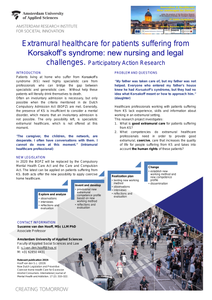ABSTRACT: Introduction: The literature shows that Korsakoff’s syndrome is associated with a wide range of severe comorbid somatic and psychiatric health problems that lead to care needs in several domains of functioning. Aim: To provide a comprehensive overview of Korsakoff patients’ health conditions and related care needs. Method: Following the PRISMA guidelines, we searched MedLine, PsycInfo, Cochrane Library and CINAHL up to January 2019. After applying our inclusion criteria, two reviewers independently selected the studies, extracted the data, and assessed methodological quality. Results: Twelve articles were included. The commonest somatic comorbid conditions were liver disease, cardiovascular disease, COPD and diabetes mellitus. The commonest psychiatric comorbid conditions were mood disorder, personality disorder and psychotic disorder. Anxiety, aggressive/agitated behaviour, depressive symptoms and care needs in social functioning and (instrumental) activities of daily living were also very commonly reported. Discussion: In patients with Korsakoff's syndrome, somatic and psychiatric comorbid conditions co-occur with behavioural and functional problems. They are compounded by patients’ poor self-awareness regarding their health status and functioning. Adequate responses to their care needs require high-quality integrated care.
LINK
Patients living at home who suffer from Korsakoff's syndrome (KS) need highly specialistic care from competent healthcare professionals who can bridge the gap between specialistic and generalistic care. Patients suffering from KS lack insight into their illness and often do not have any care demands for themselves. A voluntary admission is not at issue.However, they need professional care due to physical and mental deterioration and without help they will literally drink themselves to death. An involuntary admission is only possible when the criteria mentioned in the Dutch Compulsory Admission Act (BOPZ) are met. Generally, the presence of KS is insufficient to consider a mental disorder, which means that an involuntary admission will not be possible. The only possibility for this group will be extramural healthcare.In 2020 two new acts will replace the BOPZ. The Compulsory Mental Health Care Act (WvGGZ) and the Care and Compulsion Act (WZD). The WZD can be applied on patients suffering from Korsakoff's syndrome. Both acts offer the possibility to apply coercive home healthcare.Healthcare professionals working with patients suffering from KS note that they are missing experience, skills and information about working in an extramural setting. What competencies do they need to provide good care for people with KS? New challenges are created when the new legislation has to be applied. This research project investigates, firstly, what good extramural care is for patients suffering from KS. Secondly, what competencies extramural healthcare professionals need in order to provide care that increases the quality of life of people with KS, meet the needs of people with KS and their informal caregivers, and takes into account the human rights of these patients.
DOCUMENT

Excessive alcohol consumers are in need for effective and targeted thiamine interventions to prevent the development of Korsakoff’s syndrome. Coercive home health care might be a solution to reach excessive alcohol consumers. In many parts of the world, an expansion is seen of more coercive community practices. Due to new legislation in the Netherlands, preventive coercive home health care is permitted. The objective of this article is twofold. Firstly, to describe this new Dutch legislation and secondly, to explore literature to identify themes that might contribute to less-intrusive coercive interventions at the excessive alcohol consumer’s home. Four articles have been identified which concentrate on experiences regarding coercive home health care. Preventive coercive home health care might benefit from a stable and trusting relationship. For healthcare organizations, this means that they need to pay attention to the health and safety of their employees to prevent outflow.
DOCUMENT